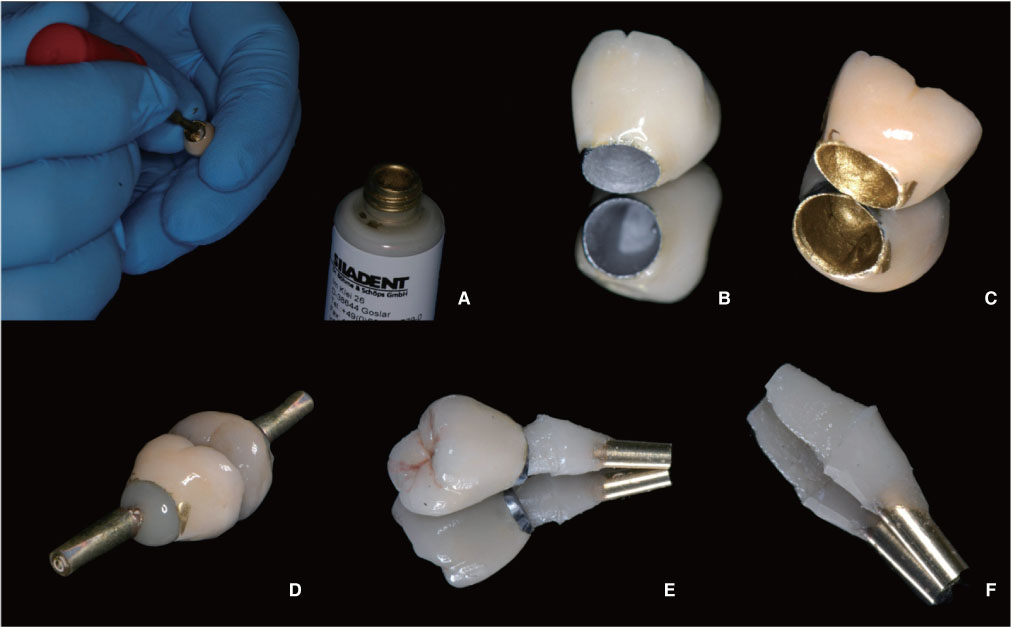J Adv Prosthodont.
2014 Apr;6(2):146-149. 10.4047/jap.2014.6.2.146.
A modified technique for extraoral cementation of implant retained restorations for preventing excess cement around the margins
- Affiliations
-
- 1Department of Prosthodontics, School of Dentistry, Istanbul Medipol University, Istanbul, Turkey. eyuzbasioglu@medipol.edu.tr
- KMID: 2233344
- DOI: http://doi.org/10.4047/jap.2014.6.2.146
Abstract
- The major drawback of cement-retained restorations is the extrusion of the excess cement into the peri-implant sulcus, with subsequent complications. Insufficient removal of the excess cement may initiate a local inflammatory process, which may lead to implant failure. This article presents a method of controlling cement flow on implant abutments, minimizing the excess cement around implant-retained restorations.
MeSH Terms
Figure
Reference
-
1. Brånemark PI, Zarb GA, Albrektsson T. Tissue-Integrated Prosthesis: Osseointegration in Clinical Dentistry. Chicago: Quintessence Publishing;1985.2. Wannfors K, Smedberg JI. A prospective clinical evaluation of different single-tooth restoration designs on osseointegrated implants. A 3-year follow-up of Brånemark implants. Clin Oral Implants Res. 1999; 10:453–458.3. Eckert SE, Wollan PC. Retrospective review of 1170 endosseous implants placed in partially edentulous jaws. J Prosthet Dent. 1998; 79:415–421.4. Avivi-Arber L, Zarb GA. Clinical effectiveness of implant-supported single-tooth replacement: the Toronto Study. Int J Oral Maxillofac Implants. 1996; 11:311–321.5. Michalakis KX, Hirayama H, Garefis PD. Cement-retained versus screw-retained implant restorations: a critical review. Int J Oral Maxillofac Implants. 2003; 18:719–728.6. Hebel KS, Gajjar RC. Cement-retained versus screw-retained implant restorations: achieving optimal occlusion and esthetics in implant dentistry. J Prosthet Dent. 1997; 77:28–35.7. Jones JD, Kaiser DA. A new gingival retraction impression system for a one-stage root-form implant. J Prosthet Dent. 1998; 80:371–373.8. Misch CE. Contemporary implant dentistry. 2nd ed. St. Louis; MO: Mosby-Year Book Inc;1999. p. 549–573.9. Breeding LC, Dixon DL, Bogacki MT, Tietge JD. Use of luting agents with an implant system: Part I. J Prosthet Dent. 1992; 68:737–741.10. Quirynen M, De Soete M, van Steenberghe D. Infectious risks for oral implants: a review of the literature. Clin Oral Implants Res. 2002; 13:1–19.11. Lee A, Okayasu K, Wang HL. Screw- versus cement-retained implant restorations: current concepts. Implant Dent. 2010; 19:8–15.12. Pauletto N, Lahiffe BJ, Walton JN. Complications associated with excess cement around crowns on osseointegrated implants: a clinical report. Int J Oral Maxillofac Implants. 1999; 14:865–868.13. Gapski R, Neugeboren N, Pomeranz AZ, Reissner MW. Endosseous implant failure influenced by crown cementation: a clinical case report. Int J Oral Maxillofac Implants. 2008; 23:943–946.14. Wilson TG Jr. The positive relationship between excess cement and peri-implant disease: a prospective clinical endoscopic study. J Periodontol. 2009; 80:1388–1392.15. Agar JR, Cameron SM, Hughbanks JC, Parker MH. Cement removal from restorations luted to titanium abutments with simulated subgingival margins. J Prosthet Dent. 1997; 78:43–47.16. Dumbrigue HB, Abanomi AA, Cheng LL. Techniques to minimize excess luting agent in cement-retained implant restorations. J Prosthet Dent. 2002; 87:112–114.17. Schwedhelm ER, Lepe X, Aw TC. A crown venting technique for the cementation of implant-supported crowns. J Prosthet Dent. 2003; 89:89–90.18. Wadhwani C, Piñeyro A. Technique for controlling the cement for an implant crown. J Prosthet Dent. 2009; 102:57–58.
- Full Text Links
- Actions
-
Cited
- CITED
-
- Close
- Share
- Similar articles
-
- A new retaining method of cement-retained restoration with linguo-horizontal insertion of fiber post
- A literature review on cementation of implant prosthesis
- A technique for fabricating abutment replica with hot melt adhesive material to minimize residual cement in implant restoration: a case report
- SINGLE TOOTH IMPLANT RESTORATION USING COMBINATION IMPLANT CROWN : A CASE REPORT
- Effect of abutment neck taper and cement types on the amount of remnant cement in cement-retained implant restorations: an in vitro study



